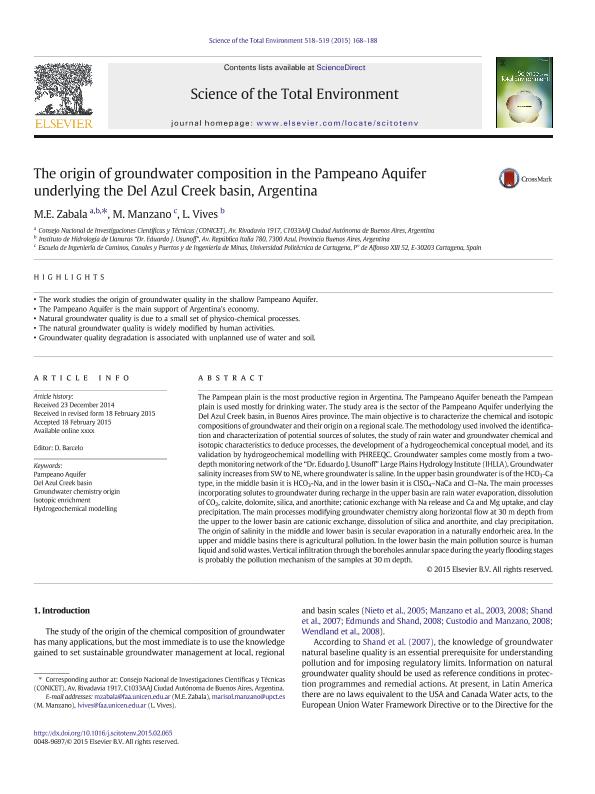Mostrar el registro sencillo del ítem
dc.contributor.author
Zabala, Maria Emilia

dc.contributor.author
Manzano, M.
dc.contributor.author
Vives, Luis Sebastián

dc.date.available
2018-06-29T15:14:18Z
dc.date.issued
2015-06
dc.identifier.citation
Zabala, Maria Emilia; Manzano, M.; Vives, Luis Sebastián; The origin of groundwater composition in the Pampeano Aquifer underlying the Del Azul Creek basin, Argentina; Elsevier Science; Science of the Total Environment; 518-519; 6-2015; 168-188
dc.identifier.issn
0048-9697
dc.identifier.uri
http://hdl.handle.net/11336/50621
dc.description.abstract
The Pampean plain is the most productive region in Argentina. The Pampeano Aquifer beneath the Pampean plain is used mostly for drinking water. The study area is the sector of the Pampeano Aquifer underlying the Del Azul Creek basin, in Buenos Aires province. The main objective is to characterize the chemical and isotopic compositions of groundwater and their origin on a regional scale. The methodology used involved the identification and characterization of potential sources of solutes, the study of rain water and groundwater chemical and isotopic characteristics to deduce processes, the development of a hydrogeochemical conceptual model, and its validation by hydrogeochemical modelling with PHREEQC. Groundwater samples come mostly from a two-depth monitoring network of the "Dr. Eduardo J. Usunoff" Large Plains Hydrology Institute (IHLLA). Groundwater salinity increases from SW to NE, where groundwater is saline. In the upper basin groundwater is of the HCO3-Ca type, in the middle basin it is HCO3-Na, and in the lower basin it is ClSO4-NaCa and Cl-Na. The main processes incorporating solutes to groundwater during recharge in the upper basin are rain water evaporation, dissolution of CO2, calcite, dolomite, silica, and anorthite; cationic exchange with Na release and Ca and Mg uptake, and clay precipitation. The main processes modifying groundwater chemistry along horizontal flow at 30m depth from the upper to the lower basin are cationic exchange, dissolution of silica and anorthite, and clay precipitation. The origin of salinity in the middle and lower basin is secular evaporation in a naturally endorheic area. In the upper and middle basins there is agricultural pollution. In the lower basin the main pollution source is human liquid and solid wastes. Vertical infiltration through the boreholes annular space during the yearly flooding stages is probably the pollution mechanism of the samples at 30m depth.
dc.format
application/pdf
dc.language.iso
eng
dc.publisher
Elsevier Science

dc.rights
info:eu-repo/semantics/openAccess
dc.rights.uri
https://creativecommons.org/licenses/by-nc-sa/2.5/ar/
dc.subject
Del Azul Creek Basin
dc.subject
Groundwater Chemistry Origin
dc.subject
Hydrogeochemical Modelling
dc.subject
Isotopic Enrichment
dc.subject
Pampeano Aquifer
dc.subject.classification
Meteorología y Ciencias Atmosféricas

dc.subject.classification
Ciencias de la Tierra y relacionadas con el Medio Ambiente

dc.subject.classification
CIENCIAS NATURALES Y EXACTAS

dc.title
The origin of groundwater composition in the Pampeano Aquifer underlying the Del Azul Creek basin, Argentina
dc.type
info:eu-repo/semantics/article
dc.type
info:ar-repo/semantics/artículo
dc.type
info:eu-repo/semantics/publishedVersion
dc.date.updated
2018-06-29T13:04:07Z
dc.journal.volume
518-519
dc.journal.pagination
168-188
dc.journal.pais
Países Bajos

dc.journal.ciudad
Amsterdam
dc.description.fil
Fil: Zabala, Maria Emilia. Consejo Nacional de Investigaciones Científicas y Técnicas; Argentina. Universidad Nacional del Centro de la Provincia de Buenos Aires. Rectorado. Instituto de Hidrología de Llanuras - Sede Azul. Provincia de Buenos Aires. Gobernación. Comisión de Investigaciones Científicas. Instituto de Hidrología de Llanuras - Sede Azul; Argentina
dc.description.fil
Fil: Manzano, M.. Universidad Politécnica de Cartagena; España
dc.description.fil
Fil: Vives, Luis Sebastián. Universidad Nacional del Centro de la Provincia de Buenos Aires. Rectorado. Instituto de Hidrología de Llanuras - Sede Azul. Provincia de Buenos Aires. Gobernación. Comisión de Investigaciones Científicas. Instituto de Hidrología de Llanuras - Sede Azul; Argentina
dc.journal.title
Science of the Total Environment

dc.relation.alternativeid
info:eu-repo/semantics/altIdentifier/doi/https://dx.doi.org/10.1016/j.scitotenv.2015.02.065
Archivos asociados
